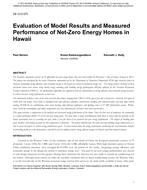Click here to purchase
Building systems, including Heating, Ventilation and Air-conditioning (HVAC) systems, lighting systems, and security systems are key components of modern buildings. These systems are designed to deliver an ideal built environment, ensure the quality of building service and safety. The implementation of Building Automation System (BAS) has facilitated the building Operation and Maintenance (O&M), allowing building operators to better monitor and regulate building functions. One of the important abilities of modern BAS is raising alarms when building systems behave differently from design values. However, BAS usually generates an excessive amount of alarms every day. The lack of actionable information from those alarms makes it very challenging for building operators to take actions. The intent of this study is to find the reasons of the inefficiency of BAS alarm functions and to propose a solution which helps building operators make better O&M decisions based on the BAS alarms. This study analyzed a BAS in a university complex. First, the building’s HVAC systems were investigated. Second, interviews with facility managers and BAS field engineers were conducted to identify the existing deficiencies of BAS and future user expectations. Third, a data-mining framework was constructed to optimize current BAS alarm management function. The goal of this framework is to help filter out trivial alarms, categorize alarms by their impact category (e.g. equipment-related, occupantrelated, critical equipment operations), and prioritize the alarms based on the quantitative impacts. This paper presents an alarm management optimization solution for an 111754 sqft-complex on Carnegie Mellon University campus in Pittsburgh, PA. This study found that a good BAS alarm management function should be a collaborative effort among designers, BAS engineers, and building operators. Current deficiencies of BAS alarm management are caused by poor rule definitions and information isolations. The framework from this study could effectively filter out the trivial alarms from BAS, and provide actionable information for building operators.
Citation: 2018 Winter Conference, Chicago, IL, Conference Papers
Product Details
- Published:
- 2018
- Number of Pages:
- 8
- Units of Measure:
- Dual
- File Size:
- 1 file , 1.3 MB
- Product Code(s):
- D-CH-18-C001


